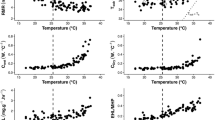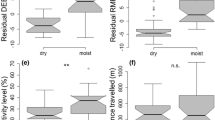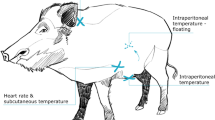Abstract
Springhares are large, nocturnally active, diurnally fossorial rodents that typically inhabit arid and semi-arid areas. This lifestyle means that they need to balance excessive heat loss when foraging at night against insufficient heat loss in a potentially warm, humid burrow and both of these against the need to minimize water turnover and energy requirements. In this study we investigated metabolism and thermoregulation in these animals. Basal metabolic rate averaged 8.62±1.37 J g−1 h−1 and minimum thermal conductance 0.386±0.062 J g−1 h−1 °C−1. These were higher and lower than expected, respectively. This, along with a relatively low, lower critical temperature and broad thermal neutral zone indicate that springhares are physiologically well suited to the low night-time temperatures, which they typically encounter. Body temperatures were quite labile but springhares became hyperthermic at temperatures above 30 °C suggesting that they are poor thermoregulators at high temperatures. This is attributed to their seldom, if ever, encountering temperatures in this range. Insufficient heat loss under normal resting conditions does not appear to be a problem, as springhares inhabit deep burrows in which the temperature never exceeds the upper critical temperature. Excess heat generated during vigorous underground exercise is presumably stored and dissipated to the cool night air or the cooler soil when subsequently resting. Water turnover and energy expenditure are presumably adequately addressed by other physiological and behavioural characteristics.





Similar content being viewed by others
Abbreviations
- BMR :
-
basal metabolic rate
- C :
-
wet thermal conductance
- STPD :
-
standard temperature and pressure of dry air
- T a :
-
ambient (chamber) temperature
- T b :
-
body temperature
- TNZ :
-
thermal neutral zone
References
Anderson PC (1996) The population dynamics and ecological role of the springhare Pedetes capensis (Forster, 1778) in the Kimberley area, Northern Cape Province, South Africa. PhD Thesis. University of the Orange Free State
Baudinette RV (1972) Energy metabolism and evaporative water loss in the California ground squirrel. J Comp Physiol 81:57–72
Borut A, Shkolnik A (1974) Physiological adaptations to the desert environment. In: Robertshaw D (ed) MTP international review of science, physiology. Series 1. Environmental physiology. Butterworth, London, pp 185–229
Bradley SR, Deavers DR (1980) A re-examination of the relationship between thermal conductance and body weight in mammals. Comp Biochem Physiol A 65:465–476
Butynski TM (1984) Nocturnal ecology of the springhare, Pedetes capensis, in Botswana. Afr J Ecol 22:7–22
Butynski TM, Mattingly R (1979) Burrow structure and fossorial ecology of the springhare Pedetes capensis in Botswana. Afr J Ecol 17:205–215
Degen AA (1997) Ecophysiology of small desert mammals. Springer, Berlin Heidelberg New York
Downs CT, Perrin MR (1990) Thermal parameters of four species of Gerbillurus. J Thermal Biol 15:291–300
Gettinger RD (1975) Metabolism and thermoregulation of a fossorial rodent, the northern pocket gopher (Thomomys talpoides). Physiol Zool 48:311–322
Gettinger RD (1984) Energy and water metabolism of free-ranging pocket gophers, Thomomys bottae. Ecology 65:740–751
Glenn ME (1970) Water relations in three species of deer mice (Peromyscus). Comp Biochem Physiol A 33:231–248
Goyal SP, Ghosh PK (1983) Body weight exponents of metabolic rate and minimal thermal conductance in burrowing desert rodents. J Arid Environ 6:43–52
Hainsworth FR (1967) Saliva spreading, activity, and body temperature regulation in the rat. Am J Physiol 212:1288–1292
Hart JS (1971) Rodents. In: Whittow GC (ed) Comparative physiology of thermoregulation, vol. II. Academic Press, New York, pp 1–149
Hayssen V, Lacy RC (1985) Basal metabolic rates in mammals: taxonomic differences in the allometry of BMR and body mass. Comp Biochem Physiol A 81:741–754
Hinds DS, MacMillen RE (1985) Scaling of energy metabolism and aerobic capacity in heteromyid rodents. Physiol Zool 58:282–298
Hudson JW (1962) The role of water in the biology of the antelope ground squirrel, Citellus leucurus. University of California Publications 64:1–56
Kronfeld N, Shkolnik A (1996) Adaptations to life in the desert in the brown hare (Lepus capensis). J Mammal 77:171–178
Levy A (1964) The accuracy of the bubble method for gas flow measurements. Sci Instrument 41:449–453
Lovegrove BG (1986) Thermoregulation of the subterranean rodent genus Bathyergus (Bathyergidae). S Afr J Zool 21:283–288
Lovegrove BG (1987) Thermoregulation in the subterranean rodent Georychus capensis (Rodentia: Bathyergidae). Physiol Zool 60:174–180
Lovegrove BG (2000) The zoogeography of mammalian basal metabolic rate. Am Nat 156:201–219
MacMillen RE (1965) Aestivation in the cactus mouse, Peromyscus eremicus. Comp Biochem Physiol A 16:227–248
MacMillen RE (1972) Water economy of nocturnal desert rodents. Symp Zool Soc Lond 31:147–174
MacMillen RE, Lee AK (1970) Energy metabolism and pulmocutaneous water loss of Australian hopping mice. Comp Biochem Physiol 35:355–369
Matthee CA, Robinson TJ (1997) Mitochondrial DNA phylogeography and comparative cytogenetics of the springhare, Pedetes capensis (Mammalia: Rodentia). J Mammal Evol 4:53–73
McNab BK (1966) The metabolism of fossorial rodents: a study of convergence. Ecology 47:712–733
McNab BK (1970) Body weight and the energetics of temperature regulation. J Exp Biol 53:329–348
McNab BK (1979a) Climatic adaptation in the energetics of heteromyid rodents. Comp Biochem Physiol A 62:813–820
McNab BK (1979b) The influence of body size on the energetics and distribution of fossorial and burrowing animals. Ecology 60:1010–1021
McNab BK (1980) On estimating thermal conductance in endotherms. Physiol Zool 53:145–156
McNab BK, Morrison PR (1963) Body temperature and metabolism in subspecies of Peromyscus from arid and mesic environments. Ecol Monogr 33:63–82
Müller EF, Kamau JMZ, Maloiy GMO (1979) O2-Uptake, thermoregulation and heart rate in the springhare (Pedetes capensis). J Comp Physiol B 133:187–191
Murie M (1961) Metabolic characteristics of mountain, desert and coastal populations of Peromyscus. Ecology 42:723–740
Neal CM, Lustick SI (1973) Energetics and evaporative water loss in the short-tailed shrew Blarina brevicauda. Physiol Zool 46:180–185
Needham AD, Dawson TJ, Hales JRS (1974) Forelimb blood flow and saliva spreading in the thermoregulation of the red kangaroo, Megaleia rufa. Comp Biochem Physiol A 49:555–565
Peinke DM (2000) The ecology and physiology of the springhare (Pedetes capensis) in the Eastern Cape Province of South Africa. PhD Thesis. Rhodes University, Grahamstown
Peinke DM, Brown CR (1999) Osmoregulation and water balance in the springhare Pedetes capensis. J Comp Physiol B 169:1–10
Prakash I, Ghosh PK (1975) Rodents in desert environments. Junk, The Hague
Reinking LN, Kilgore DL, Fairbanks ES, Hamilton JD (1977) Temperature regulation in normothermic black-tailed prairie dogs, Cynomys ludovicianus. Comp Biochem Physiol A 57:161–165
Schmidt-Nielsen K (1964) Desert animals: physiological problems of heat and water. Oxford University Press, London
Schmidt-Nielsen K (1990) Animal physiology: adaptation and environment. Cambridge University Press, Cambridge
Schmidt-Nielsen K, Schmidt-Nielsen B, Jarnum SA, Houpt TR (1957) Body temperature of the camel and its relation to water economy. Amer J Physiol 188:103–112
Schulze BR (1947) The climates of South Africa according to the classifications of Köppen and Thornthwaite. S Afr Geogr J 29:32–42
Schulze BR (1986) Climate of South Africa. Part 8. General survey. Weather Bureau, Department of Environmental Affairs, Pretoria
Skinner JD, Smithers RHN (1990) The mammals of the southern African subregion. University of Pretoria, Pretoria
Smithers RHN (1971) The mammals of Botswana. National Museums and Monuments of Rhodesia, Museum Memoir No. 4. Mardon Printers, Salisbury
Taylor CR, Sale JB (1969) Temperature regulation in the hyrax. Comp Biochem Physiol 31:903–907
Thompson BW (1967) Climate. In: Morgan WTW (ed) Nairobi: City and Region. Oxford University Press, London, pp 20–38
Wunder BA (1970) Temperature regulation and the effects of water restriction on Merriam's chipmunk, Eutamias merriami. Comp Biochem Physiol 33:385–403
Acknowledgements
We thank Alan Page and Jimmy Emslie for allowing us to catch springhares on their farms, as well as all those who assisted in the capture of the animals. The study was conducted under the guidelines and with the approval of the Rhodes University Animal Ethics Committee. Financial support of the South African National Research Foundation and the Rhodes University Joint Research Committee is gratefully acknowledged.
Author information
Authors and Affiliations
Corresponding author
Additional information
Communicated by G. Heldmaier
Rights and permissions
About this article
Cite this article
Peinke, D.M., Brown, C.R. Metabolism and thermoregulation in the springhare (Pedetes capensis). J Comp Physiol B 173, 347–353 (2003). https://doi.org/10.1007/s00360-003-0344-x
Accepted:
Published:
Issue Date:
DOI: https://doi.org/10.1007/s00360-003-0344-x




